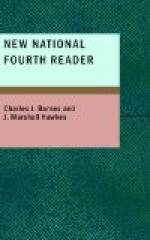[Illustration]
Its tongue is very wonderful. It is from thirteen to seventeen inches in length, is slender and pointed, and is capable of being moved in various ways. It is almost as useful to the giraffe as the trunk is to the elephant.
The horns of the giraffe are very short and covered with skin. At the ends there are tufts of short hair. The animal has divided hoofs somewhat resembling those of the ox.
The head of the giraffe is small, and its eyes, large and mild looking. These eyes are set in such a way that the animal can see a great deal of what is behind it without turning its head.
In addition to its wonderful power of sight, the giraffe can scent danger from a great distance; so there is no animal more difficult of approach.
Strange to relate, the giraffe has no voice. In London, some years ago, two giraffes were burned to death in their stables, when the slightest sound would have given notice of their danger, and saved their lives.
The giraffe is naturally both gentle and timid, and he will always try to avoid danger by flight. It is when running that he exposes his only ungraceful point.
He runs swiftly, but as he moves the fore and hind legs on each side at the same time, it gives him a very displeasing and awkward gait.
But though timid, he will, when overtaken, turn even upon the lion or panther, and defend himself successfully by powerful kicks with his strong legs.
The natives of Africa capture the giraffe in pitfalls, which are deep holes covered over with branches of trees and dirt. When captured, he can be tamed, and gives scarcely any trouble during captivity.
Fifty years ago, but little was known about giraffes in Europe or America. Now we can find them in menageries and the public gardens of our large cities.
The giraffe thrives in captivity and seems to be well satisfied with a diet of corn and hay. It is a source of great satisfaction to those who admire this beautiful animal, that there is no reason which prevents him from living in a climate so different from that of his African home.
* * * * *
Language Lesson.—Write statements containing each of the following words, used in such a manner as to show their proper meaning: feet, feat; red, read; fore, four; gait, gate.
Model.—
We are coming to see you to-morrow.
He stood watching the ships sailing on the sea.
* * * * *
LESSON XIX.
ex pert’, skillful.
ad vise’, offer advice; give notice of what has happened.
civ’il ized, having laws, learning, and good manners.
quan’ti ty, a large amount; part.
in duce’, lead one to think or act.




